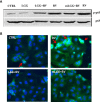Lacticaseibacillus rhamnosus GG Counteracts Rotavirus-Induced Ion Secretion and Enterocyte Damage by Inhibiting Oxidative Stress and Apoptosis Through Specific Effects of Living and Postbiotic Preparations
- PMID: 35425719
- PMCID: PMC9001969
- DOI: 10.3389/fcimb.2022.854989
Lacticaseibacillus rhamnosus GG Counteracts Rotavirus-Induced Ion Secretion and Enterocyte Damage by Inhibiting Oxidative Stress and Apoptosis Through Specific Effects of Living and Postbiotic Preparations
Abstract
Background: Administration of Lacticaseibacillus rhamnosus GG (LGG) to children with gastroenteritis is recommended by universal guidelines. Rotavirus (RV) causes diarrhea through combined cytotoxic and enterotoxic effects. Aim of this study was to evaluate the mechanisms of efficacy of LGG in an in-vitro model of RV diarrhea in its viable form (LGG) and conditioned medium (mLGG).
Methods: Ion secretion corresponding to the NSP4 enterotoxic effect, was evaluated by short circuit current (Isc) and the cytotoxic effect by transepithelial electrical resistance (TEER) in Ussing chambers, upon exposure to RV in Caco-2 enterocyte monolayers treated or not with living probiotic or its culture supernatant. Mechanisms of enterotoxic and cytotoxic damage were evaluated including oxidative stress measured by reactive oxygen species, apoptosis evaluated by DAPI and nuclear staining, NFkβ immunofluorescence.
Results: RV induced Isc increase and TEER decrease, respectively indicating ion secretion and epithelial damage, the two established pathways of diarrhea. Both probiotic preparations reduced both diarrheal effects, but their potency was different. Live LGG was equally effective on both enterotoxic and cytotoxic effect whereas mLGG was highly effective on ion secretion and showed minimal protective effects on cytoskeleton, apoptosis and NFkβ.
Conclusions: LGG counteracts RV-induced diarrhea by inhibiting both cytotoxic and enterotoxic pathogenic mechanisms. Namely, LGG inhibits chloride secretion by specific moieties secreted in the medium with a direct pharmacologic-like action. This is considered a postbiotic effect. Subsequently, live bacteria exert a probiotic effect protecting the enterocyte structure.
Keywords: Lacticaseibacillus rhamnosus GG; diarrhea; enterocyte damage; gastroenteritis; oxidative stress; postbiotics; probiotics; rotavirus.
Copyright © 2022 Buccigrossi, Poeta, Cioffi, Terranova, Nunziata, Lo Vecchio and Guarino.
Conflict of interest statement
The study was in part supported by Dicofarm S.p.A. The funding sponsors had no role in the design of the study; in the collection, analyses, or interpretation of data; in the writing of the manuscript, and in the decision to publish the results. All authors declare no other competing interests.
Figures





Similar articles
-
Postbiotic Preparation of Lacticaseibacillus rhamnosus GG against Diarrhea and Oxidative Stress Induced by Spike Protein of SARS-CoV-2 in Human Enterocytes.Antioxidants (Basel). 2023 Oct 19;12(10):1878. doi: 10.3390/antiox12101878. Antioxidants (Basel). 2023. PMID: 37891957 Free PMC article.
-
Immune response and intestinal permeability in children with acute gastroenteritis treated with Lactobacillus rhamnosus GG: a randomized, double-blind, placebo-controlled trial.Clin Infect Dis. 2014 Apr;58(8):1107-15. doi: 10.1093/cid/ciu065. Epub 2014 Feb 5. Clin Infect Dis. 2014. PMID: 24501384 Free PMC article. Clinical Trial.
-
Shear-Enhanced Dynamic Adhesion of Lactobacillus rhamnosus GG on Intestinal Epithelia: Correlative Effect of Protein Expression and Interface Mechanics.Langmuir. 2019 Jan 15;35(2):529-537. doi: 10.1021/acs.langmuir.8b02931. Epub 2019 Jan 2. Langmuir. 2019. PMID: 30567428
-
Rotavirus immunisation status affects the efficacy of Lacticaseibacillus rhamnosus GG for the treatment of children with acute diarrhoea: a meta-analysis.Benef Microbes. 2022 Oct 4;13(4):283-294. doi: 10.3920/BM2022.0024. Epub 2022 Aug 25. Benef Microbes. 2022. PMID: 36004717 Review.
-
Efficacy of Lactobacillus rhamnosus GG in treatment of acute pediatric diarrhea: A systematic review with meta-analysis.World J Gastroenterol. 2019 Sep 7;25(33):4999-5016. doi: 10.3748/wjg.v25.i33.4999. World J Gastroenterol. 2019. PMID: 31543689 Free PMC article.
Cited by
-
Postbiotic Preparation of Lacticaseibacillus rhamnosus GG against Diarrhea and Oxidative Stress Induced by Spike Protein of SARS-CoV-2 in Human Enterocytes.Antioxidants (Basel). 2023 Oct 19;12(10):1878. doi: 10.3390/antiox12101878. Antioxidants (Basel). 2023. PMID: 37891957 Free PMC article.
-
Postbiotic Potential of Newly Isolated Riboflavin-Overproducing Lactiplantibacillus plantarum Strains.Probiotics Antimicrob Proteins. 2025 Apr 23. doi: 10.1007/s12602-025-10538-x. Online ahead of print. Probiotics Antimicrob Proteins. 2025. PMID: 40268810
-
Advances in the development of antivirals for rotavirus infection.Front Immunol. 2023 Mar 17;14:1041149. doi: 10.3389/fimmu.2023.1041149. eCollection 2023. Front Immunol. 2023. PMID: 37006293 Free PMC article. Review.
-
Lactobacillus rhamnosus GG powder supplementation alleviates intestinal injury in piglets challenged by porcine epidemic diarrhea virus.Front Cell Infect Microbiol. 2024 Apr 23;14:1371916. doi: 10.3389/fcimb.2024.1371916. eCollection 2024. Front Cell Infect Microbiol. 2024. PMID: 38716199 Free PMC article.
-
The effect of probiotic, prebiotic, and synbiotic supplements on anthropometric measures and respiratory infections in malnourished children: a systematic review and meta-analysis of randomized controlled trials.BMC Pediatr. 2024 Nov 6;24(1):702. doi: 10.1186/s12887-024-05179-y. BMC Pediatr. 2024. PMID: 39506703 Free PMC article.
References
-
- Bruzzese E., Callegari M. L., Raia V., Viscovo S., Scotto R., Ferrari S., et al. . (2014). Disrupted Intestinal Microbiota and Intestinal Inflammation in Children With Cystic Fibrosis and Its Restoration With Lactobacillus GG: A Randomised Clinical Trial. PloS One 9, e87796. doi: 10.1371/journal.pone.0087796 - DOI - PMC - PubMed
Publication types
MeSH terms
LinkOut - more resources
Full Text Sources

